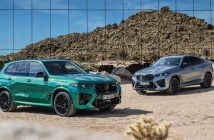+++ ASTON MARTIN has received almost 11 million euro funding from the British government to accelerate its electrification program, which is set to yield the firm’s first emission-free car in late 2025. The funding will help Aston Martin to develop a new platform for a range of electric cars. This will start with a new SUV that will be followed by a GT by the end of the decade. “The government backing represents a major boost to Aston’s R&D program”, said chief technology officer Roberto Fedeli. He added: “Providing further resources to explore the possibilities of our bespoke EV platform, it will help achieve our ambition to be an in-house BEV technology leader in the ultra-luxury, high-performance segment”. Aston Martin’s new platform will be powered by motor and battery technologies supplied by American EV maker Lucid. Chairman Lawrence Stroll previously said the deal with Lucid, confirmed in June, had been more than 2,5 years in the making and that the firm had emerged as the outstanding partner for Aston’s EV aspirations after a competitive tender process. The structure of the 232 million dollar deal had Lucid take a 3.7% shareholding in Aston Martin. The company will subsequently not take forward a similarly structured deal with another shareholder, Mercedes-Benz, that it had an option on. However, its existing supply deal with Mercedes-Benz for powertrains and electrical architectures was not affected by the Lucid deal, and the EV platform would use a Mercedes electrical architecture. Aston Martin and Lucid also have a common investor in Saudi Arabia’s Public Investment Fund but Stroll said the firms were talking independently of this. “After our due diligence, Lucid exhibited the best existing technology with the highest level of horsepower and the smallest battery height”, he said. As Aston Martin only wants to have one EV platform to give it the option to launch a model into any segment, that last point is important as it will allow the brand to make the usually-challenging sports cars using Lucid battery technology. “The target for Aston Martin is to build the highest-performance EVs and we found ourselves[with Lucid of a similar mindset and very aligned. We are proud to be partners with Lucid”, said Stroll. Aston Martin will get access to Lucid’s electric drive units, which house the motor, inverter and transmission in an integrated unit. Lucid boss Peter Rawlinson said that these have 9 hp per kg of power density, which is more than double Tesla and 8 times that of Hyundai’s motors. The firm is also working on motors for racing that have 17 hp per kg. Aston’s electric cars will use 4 motors, with power outputs potentially up to 1.500 hp. “Aston Martin will use 4 motors, we will use 3”, said Rawlinson, who as well as being Lucid CEO is its chief technology officer. “Aston is taking it to the next level”. The technology will see a twin-motor front axle that will be unique to Aston Martin. Lucid will also supply battery cells and modules, and Aston will then use them in a battery pack of its own design. All components will be built in Lucid’s factory in Arizona and shipped to the United Kingdom. Rawlinson said all technology was derivative of that on the Air but with “significant software changes”. He added: “The main difference is in thermal integration and battery layout. It will be a different-shape battery pack with a software difference”. Fedeli said he hopes to have the first electric Aston drivetrain working on a test bench by the end of the year and the first mule running on roads by the start of 2024. The architecture in which the powertrain will be used will be a “fully flexible BEV platform, modular in height and wheelbase”, according to Fedeli, who said the platform was being designed to last well into the 2030s. Aston will be able to make a sports car 2 cm lower than the current 1.27 cm Aston Martin Vantage, something enabled by the compact size and design of the Lucid cells. “The most important one is the lowest one”, said Fedeli, in reference to the need for Aston to continue to make low sports cars. However, the first Aston Martin EV will not be a sports car but an electric SUV. An electric GT is tipped to follow by 2030 but sports car models are less likely for now. “If you look at the EV market evolution between now and 2030, the growth is in GT and SUV”, said Aston’s chief brand and commercial officer, Marco Mattiacci. “We’ve established a good foothold in SUVs with the DBX and have been doing GTs for 110 years. We’ll look at those segments first. Then we talk to customers and see customer appetite; this will depend whether we do a sports car. Data and credibility: those elements will shape this”. Before the electric SUV launches, Aston’s first foray into electrified powertrains will be with the Aston Martin Valhalla mid-engined supercar. A 4.0-litre twin-turbo V8 engine will power the rear wheels and twin electric motors of Aston’s own design for the fronts. The combined power output of this car is 1.016 hp, said Fedeli. +++
+++ With only a few days to go until BMW reveals its new X2, the high performance M35i has been teased on social media, showing off details like its illuminated grille, large wheels and four round exhaust pipes. Due to be revealed in full on October 11th, the petrol-powered flagship will be joined by an all-electric iX2 before going on sale early next year. Using the X1 M35i as a guide, we have plenty to draw on when it comes to the new sports model’s technical makeup, starting with the 2.0-litre turbocharged petrol engine that’s expected to power it. Producing 300 hp at 5.750 rpm and a healthy 400 Nm of torque between 2.000 rpm and 4.500 rpm, these numbers are actually very slightly behind the existing X2 M35i, due largely to stricter emissions laws being enforced in Europe. Drive will reach all 4 wheels via an 8-speed automatic transmission, with chassis hardware such as lowered and stiffened suspension with adjustable dampers, uprated brakes and a more direct steering ratio expected to feature. Like the current X2, however, the new model will lead on its aggressive styling, some of which we can already see through the camouflage and in the official teaser. Visible straight away is a more angular front end design that references the latest X6 with its down-turned kidney grilles. Within them, the X2 M35i looks to have incorporated horizontal slats à la other full-house M models, sat in a chunky and aggressive lower bumper with a new mesh insert. The rest of the body, although more heavily disguised, clearly shows a different rear end to the existing X2 thanks to a more aggressively sloping roofline and an integrated lip spoiler. This will sit above slim rear lights with BMW’s latest lighting signature, as well as four exhaust pipes in the lower bumper; another feature borrowed from M’s larger models. Inside, we expect a few new finishes and interior colour options, but it will likely keep to the X1’s simple, tech-focused design highlighted by BMW’s twin-screen interface. Rear seat headroom will likely be compromised due to that sloping roofline, but it shouldn’t affect rear legroom or overall boot space under the parcel shelf. I expect the X2 M35i to be revealed alongside the standard car and an all-electric iX2 later this year, priced just above the more family-friendly X1. +++
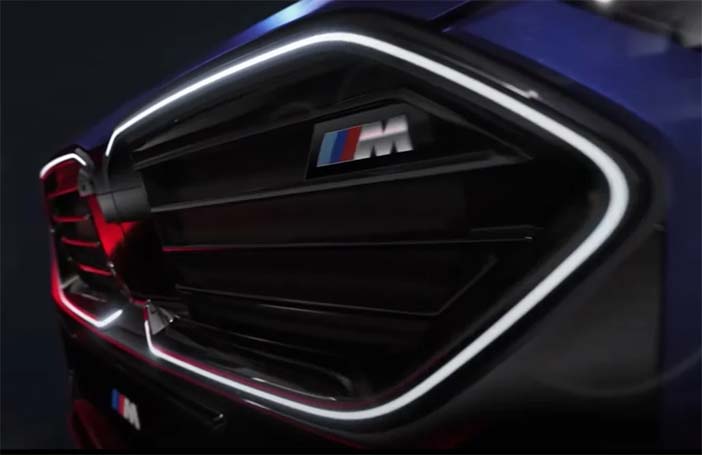
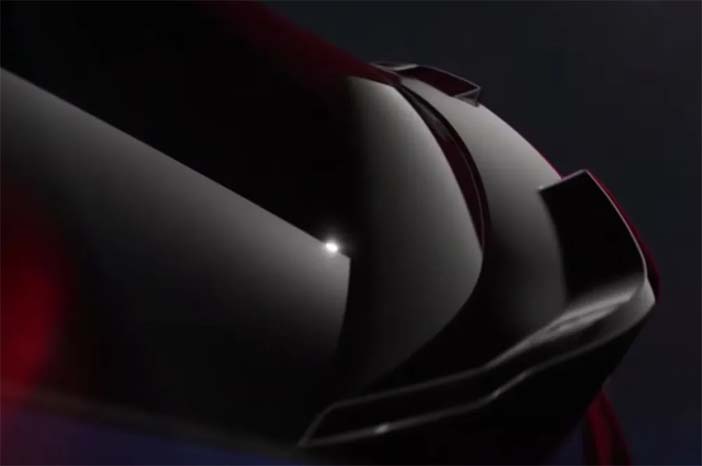
+++ ROLLS-ROYCE is to have a British boss again, after the luxury manufacturer confirmed Chris Brownridge is to replace the retiring Torsten Müller-Ötvos (photo). The current chief executive officer of BMW in the United Kingdom will take over at Rolls’s Goodwood HQ on 1 December. He said he was “honoured and humbled” by his appointment, which comes as Rolls-Royce starts its full-EV journey by delivering the first examples of its Spectre electric coupé to customers. “To be invited to lead this great British brand, at such a pivotal moment in its long and remarkable story, is an extraordinary privilege”, he said. “I’m fortunate to be following Torsten as CEO. Through his vision and ambition for the brand, Rolls-Royce is today in an exceptionally strong position, and full of confidence for the future. I’m absolutely delighted to be part of the Rolls-Royce story and look forward to embracing the challenges and opportunities that lie ahead for us all”. German Müller-Ötvos is stepping down after 14 years at the helm, making him the longest-serving boss of the company since Claude Johnson, the man who persuaded Charles Rolls and Henry Royce to work together in 1904. Under his guidance, Rolls-Royce has expanded its reach and strengthened its brand, as well as introducing its first SUV, the Cullinan, and increasing its sales figures as it has stretched into new regions like the Middle East and China. The brand’s annual sales in 2009 were around 1.000 cars per year; by 2022 that had risen to over 6.000 units. Rolls-Royce contributes over half a billion pounds to the UK economy every year, and the workforce in West Sussex has expanded from around 300 staff to over 2.500. A significant part in that success has been down to Bespoke, the customisation and tailored-vehicle division developed under Müller-Ötvos’s guidance and with input from Rolls-Royce’s clients. Müller-Ötvos said, “Leading Rolls-Royce has been the greatest privilege and pleasure of my professional life. I am proud of the role my exceptional team and I have played in contributing significantly to the UK economy and to the global recognition of Britain’s ability to produce the world’s best luxury products”. BMW Group chief executive Oliver Zipse paid tribute to Müller-Ötvos’s achievements. “Torsten’s outstanding leadership, unswerving commitment, clear vision and exceptional ability to build a strong, focused team have helped make Rolls-Royce the world-class luxury brand it is today. We wish him the very best for his future endeavours”. +++
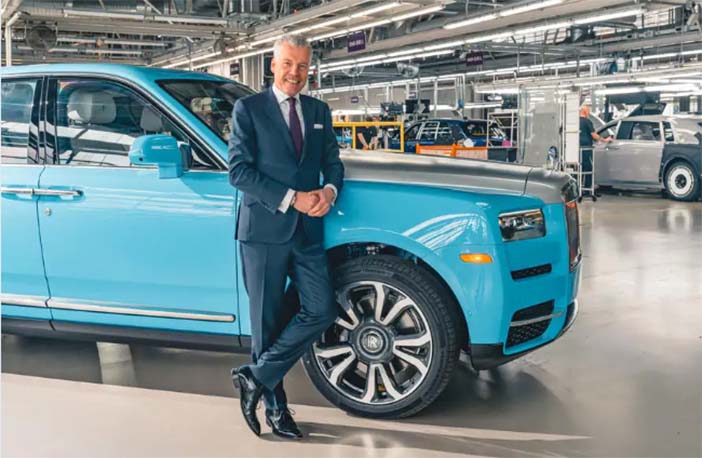
+++ A relaxation of the impending Euro 7 emissions regulations could see the lifecycle of the petrol-powered SKODA FABIA extended well into the second half of the decade. Several car company bosses have been vocal about how Euro 7 (due to be implemented in 2025) threatens the viability of small, affordable combustion cars because making them compliant with strict new limits necessitates costly engineering work to fit electrically heated e-catalysts and new on-board diagnostic technology, which drives the cost of production up to impractical levels. Indeed, Skoda boss Klaus Zellmer told earlier this year that “it will not be possible” to keep the Fabia on sale, at least at its current start price, if the plans went ahead. Driving the list price higher to compensate for the increased cost of production, he suggested, would not be a “feasible proposal for customers”. But now, the European Commission is likely to water down the initial Euro 7 proposals following pushback from countries including Spain, Italy, France and the Czech Republic, who argued that they would impose significant costs on manufacturers for little environmental benefit, and divert investment away from the collective goal of all-out electrification. Under the new proposals (yet to be ratified by the European Parliament and Commission) passenger cars would still be subject to the same limits imposed by the current Euro 6 standards, thereby substantially reducing the cost of compliance. Zellmer, speaking at the reveal of the new Kodiaq following the announcement of the less stringent Euro 7 proposals, hailed the potential move as “more realistic”. Asked if the combustion-engined Fabia could survive as a result, he said: “I wouldn’t say they have saved it, but I think they have extended its potential lifecycle”. “It still has to be ratified in the legislative EU process, so we never celebrate too early”, he added. Zellmer stopped short of suggesting a projected retirement date for the current Fabia, which was launched in 2021 and would be up for renewal in around 2028, but did reveal that the Renault Clio rival could even return for another generation if conditions allow. “We shall see”, he said. “We have to keep the options open. Our principle is that we respect customers’ preferences and we have to keep that avenue open. But let’s see what consumer preferences will be in the next 5 to 10 years”. Skoda sales boss Martin Jahn was equally optimistic about the supermini’s survival, telling: “The original proposal from the European Commission last year would kill the B-segment in the middle of 2025, which I think would be a pity because there is a big demand for these cars. If the European Parliament approves a version that’s close to what we have on the table today, then we can keep producing these cars, which I think is the right solution”. Skoda could legally continue selling a pure-combustion version of the Fabia in Europe until 2035, when manufacturers will be forced to sell only electric cars. Zellmer said the 2035 deadline is workable for Skoda, “because what we need as car manufacturers is a solid framework we can work in, and 2035 for us is a framework that we can adjust to, and manage our transformation to provide choice for consumers”. And he is reassured that Euro 7 may turn out to be less of an imposition than it was initially set to be. “If you want an example of where I was worried, and now I am less worried, it’s EU7”, he said. “The draft that was initially published was, of course, a massive question mark in our engineering heads, because nobody knew how to technically do it, it wasn’t defined how the requirements were going to be measured, whether you stick to them and not knowing exactly what that means (would add massive investment into cars that would then get more expensive) for a Fabia, €3.000 to €5.000 more expensive. Now, we see that the EU actually listens. Everybody knows that if you make the cars too expensive, motorists will stay in their old cars. They’re not going to go into EU7, they will stay in EU1, 2, 3, 4, 5 and 6. Then there’s no effect for anybody, but you have developed cars that are difficult to sell . There might be people who would say ‘why don’t you just swallow the costs as a manufacturer?’ But we need that money to manage our transformation to a CO2-neutral company”. Thomas Schäfer, CEO of Skoda sibling brand Volkswagen, had also earlier warned that Euro 7, as initially proposed, would make the Polo (closely related to the Fabia) unprofitable and thus unsustainable. It is unclear whether the looser rules could similarly extend the German car’s lifecycle. +++
+++ In the UNITED KINGDOM , the Nissan Qashqai and Ford Puma battled for new car sales supremacy in September. The overall market shows good growth including for BEV sales. New registrations jumped by 20 percent compared with last year according to figures from the Society of Motor Manufacturers and Traders (SMMT). Spurred on by the ‘73’ plate change, 272.610 new cars were registered representing the 14th consecutive month of growth, with Nissan and Ford topping the model charts with their Qashqai and Puma models only a few hundred registrations apart. This momentum has been driven by impressive fleet sales, which rose 40.8 percent compared to last year, continuing the sector’s strong performance so far in 2023. Private sales still showed growth at 5.8 percent, despite challenges such as the cost of living crisis and continued economic instability. Sales trends in regards to engine types have continued their current course, with petrol-powered models (including mild-hybrid) still representing over 55 percent of combined sales. Diesel car sales are still contracting at just 6.9 percent of the market (again, including mild-hybrid) but the recent downward trajectory is now flattening out. Battery electric vehicle (BEV) sales on the whole continue to show impressive progress, with an 18.9 percent rise, counting towards 41 months of continued sales growth, but this has been largely driven by fleet sales which accounted for a 50.6 percent increase. Private sales, by contrast, were down by 14.3 percent. Plug-in (PHEV) and full hybrid (HEV) sales also showed impressive growth at 50.9 percent and 30.7 percent respectively, spurred on by a continued increase of new models on the market.
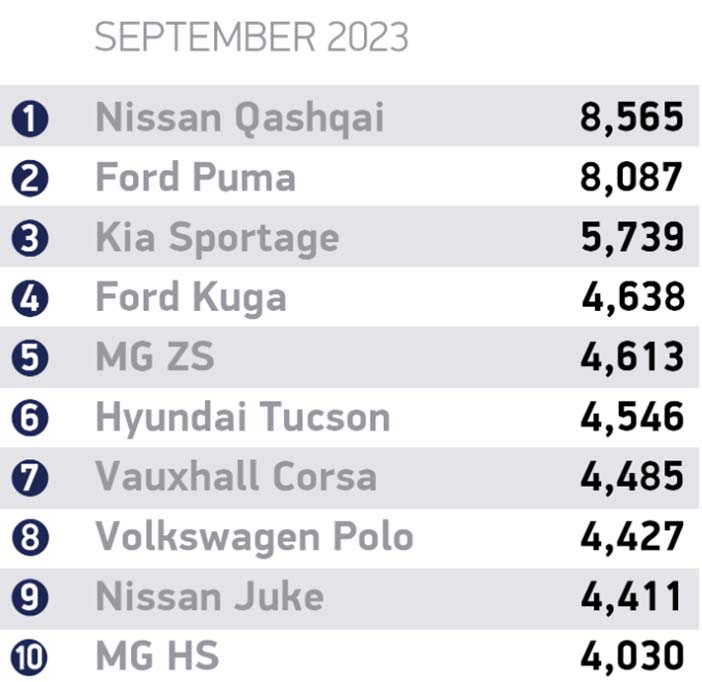
As for individual model types, the crossover is still king in the United Kingdom. Nissan’s Qashqai and the Ford Puma were closely matched at the top of the sales charts with 8.565 and 8.087 registrations respectively, followed by the Kia Sportage, Ford Kuga and MG ZS. Despite the continued contraction of the supermini class, Vauxhall’s Corsa placed in 7th with the VW Polo close behind. Overall, the Ford Puma is still the highest selling model in the UK in 2023 to date, with the Qashqai and Corsa in second and third. +++
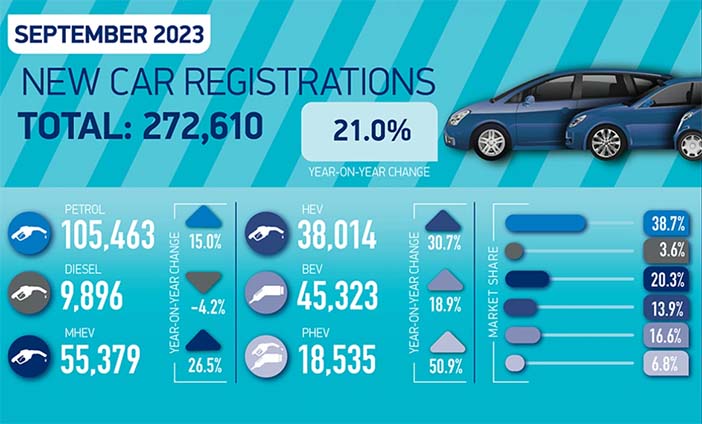
+++ The VOLKSWAGEN has been phased out of production, 12 years after it launched, leaving the Polo as the smallest model in the German firm’s line-up. The VW Group’s factory in Bratislava, Slovakia has produced the final example of the diminutive city car, which remains available from dealer stock. The Up first went on sale in 2011 as the successor to the Fox. It has been offered with a variety of powertrains over its 12-year production run. Back at launch, it could be selected with a 1.0-litre 3-cylinder petrol engine producing either 60 or 75 hp. A facelift in 2016 brought more power with the introduction of a turbocharged variant producing 90 hp. The electric Volkswagen e-Up was introduced in 2014 with an 18.7 kWh battery and a claimed 190 km of range. A larger 32.2 kWh battery was offered from 2019, which boosted range to 258 km, surpassing newer rivals such as the Mini Electric and Honda E. The decision to axe the tiny Up comes 9 months after the retirement of the hot Volkswagen Up GTI from sale. The GTI arrived in 2018 with 115 hp, a sportier design and a 6-speed manual gearbox. It was removed from sale in January this year. Volkswagen claimed this was a temporary move, due to demand outstripping supply, but it was never put back on sale. The Up was part of the Volkswagen Group’s New Small Family (NSF) vehicle series; the Seat Mii was on sale until 2020 and the Skoda Citigo until 2021. The Volkswagen Polo is now the smallest car that Wolfsburg offers. Last year, though, CEO Thomas Schäfer hinted that the Polo could be removed from the line-up in the coming years, due to Euro 7 regulations, eventually being replaced by a small electric offering in the form of the ID 2. The Up will be more directly replaced by an ultra-compact electric city car known as the Volkswagen ID.1, which is set to arrive in dealerships within the next 4 years and be priced from less than €22.000 in the Netherlands. +++

